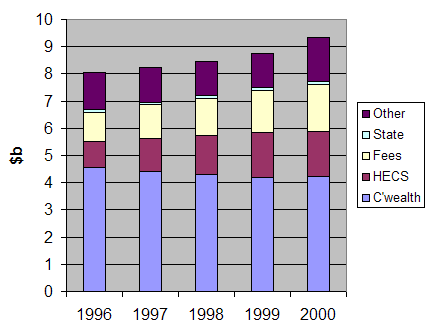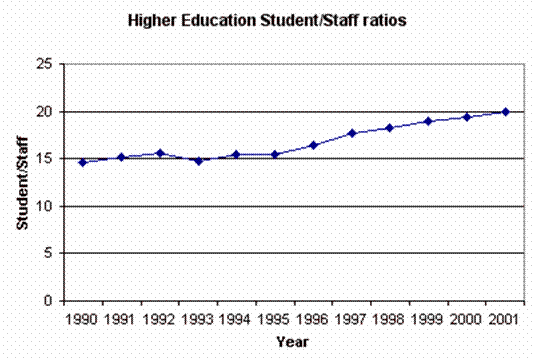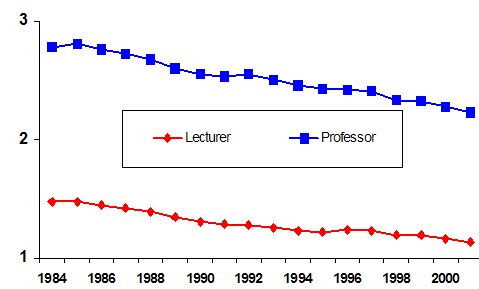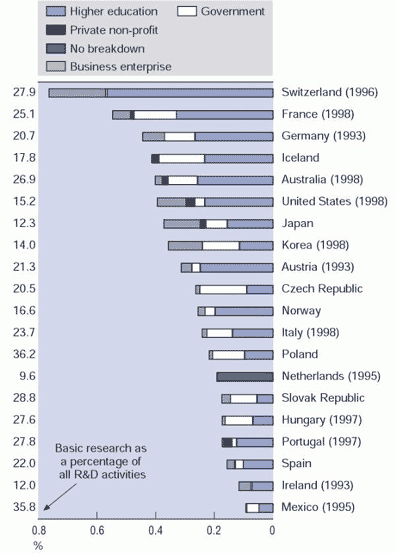|
Sections 10 and 11 from FASTS' Policy Document (2002 edition) Australian Science: Investing in the Future |
The following two sections from the new FASTS
policy document are reprinted with permission.
The full table of
contents and link to the complete document are given at the bottom of this page.
10. Higher education
It is a public responsibility to fund universities so they can advance knowledge
through research, and enthuse students through teaching. Increasingly, however,
our higher education system is having to do more with less: teaching more
students with a reduced share of total government expenditure, and relying more
heavily on limited private funds through student fees (Figure 10.1). The result
is a higher education system that is now seriously under funded. This is the key
issue that must be addressed in the current Review of Higher Education.
The Commonwealth Government's investment in higher education has declined over
the last six years, from about 0.73% GDP in 1996/97 to a projected figure of
0.55%[27] in 2002/03.

Figure 10.1 University funding from 1996-2000 (not adjusted for inflation)[28].
Student numbers have dramatically increased over the past decade, and student-to-staff ratios have risen steadily to levels exceeding those in primary or secondary schools[29] (19.9 in 2001 - Figure 10.2).

Figure 10.2 Higher Education Student/Staff Ratios: 1990-2000[30]
While productivity has increased through teaching more students per staff
member, remuneration has decreased in relative terms, with university staff
salaries falling as a function of average weekly earnings (Figure 10.3). This
compromises the capacity to attract and retain the best teachers and
researchers.

Figure 10.3 Academic Salaries as a Proportion of Average Weekly Earnings[31]
Policy 10.1 Excellence in university teaching and
research is a public responsibility and is essential to a modern economy.
Strategy 10.1.1 Government must increase resources to
address the chronic under funding of the higher education sector.
Scientific advances derived from basic research contribute to applied science
and innovation. Australia's basic research capacity exists mainly in the
university sector. It is therefore essential for innovation that the research
and teaching capability of our universities is among the best in the world.
Our universities are increasingly operating on outdated and failing equipment
which has long since reached the end of its useful life, especially in the more
expensive science and technology areas. Australia's capacity to sustain
effective access to the global network of information and knowledge is
diminishing, and maintenance of collections, libraries, and reference resources
of national and disciplinary significance is being neglected.
The position in subjects like science is exacerbated by the relative funding
models which often underestimate the true level required for high technology
subjects.
Policy 10.2 -- University infrastructure should be
funded at a level that supports the nation's basic research capacity, and
reflects the universities' role as primary provider of basic research.
Strategy 10.2.1 -- Place more emphasis on rewarding
teaching and research output quality in formula funding for university
infrastructure.
Strategy 10.2.2 -- Increase the resources available to
science and technology subjects by changing relative funding models.
Reduced funding and higher teaching loads has meant a diminished capacity to
perform research. It has been shown that a 10 per cent increase in teaching
hours can cut research by 20 per cent.[32] FASTS maintains that the best
scientific teaching environment is closely linked to strong research
environments, and the best teachers are most actively involved in scientific
research.
Policy 10.3 -- A quality research environment enriches
the quality of teaching.
Strategy 10.3.1 -- Reduce student/staff ratios and
administrative loads to ensure that the teaching and research capacity of
university staff is not compromised.
Declining funding levels in real terms have caused staff reductions,
particularly in the expensive scientific disciplines. The result has been the
disappearance of science and mathematics departments in an uncoordinated
fashion, a process that has the potential to threaten the viability of these
disciplines on a national level.
In what is rapidly becoming a differentiated university system, cooperative
action to ensure geographic access to teaching and research in major discipline
areas must be encouraged. Shared teaching and cooperation in under-represented
disciplines should enable access to all science and mathematics subjects in
every major population centre. Further, while core science and mathematics
disciplines may be widely accessible to students at one location in the early
undergraduate years, incentives could be introduced for students to relocate and
continue study in that subject in later years. Similarly, staff who teach
and have little opportunity for research or scholarship should receive support
and encouragement to share research facilities elsewhere.
Policy 10.4 -- Australia's university system should maintain a strong, internationally competitive, science and mathematics base over a range of disciplines.
Strategy 10.4.1 -- Provide incentives for universities
to cooperate to provide access to all major disciplines in teaching and research
in every major population centre.
Strategy 10.4.2 -- FASTS will encourage its Member Societies to monitor and
facilitate collaboration in teaching and research.
11. Investing in basic research
Basic research is crucial to economic performance because it is the source of a
nation's ideas. The US National Science Foundation found that 73% of
scientific articles cited in patent applications in the US are based on research
funded by American governments or foundations[33]. This emphasises the reliance
of industry on public funding which provides the bulk of support for basic
research. Without basic research, a country is forced to import costly new
technologies, products and people.
Australia has a proud record of achievement in basic research and has in the
past contributed strongly to the world scientific knowledge base (Figure
11.1). But there is growing evidence of a slump in the Australia's performance
in the funding of science and hence in its research output. Between 1997 and
1999, Australia's commitment to basic research as a percentage of GDP fell from
0.45% to 0.40%. The latest OECD information is below shown in Figure 11.1.

Figure 11.1 Basic research by sector as a percentage of GDP.[34]
More recently, this decline may have been accentuated as significant increases
have occurred in public investment in basic research by governments in the USA,
Korea, Japan, France, Germany, UK and Canada[35] as these countries recognise
the importance of basic research to their economic development.
An awareness of our competitors' advantage in recent years, prompted by reviews
within various research sectors, has seen a sea change in the way in which
Australia perceives basic research. Both Labor's Knowledge Nation and the
Coalition Government's Backing Australia's Ability indicated bipartisan support
for an increase in the funding of basic research, and has led to the doubling of
NH&MRC and ARC funding.
However, Australia's university infrastructure continues to erode (Section 10),
and Australia's funding increases are modest compared to other countries.
Australia needs to take the next step beyond BAA to continue the increase in
public funding of basic research if it is not to fall further behind our
international competitors.
Policy 11.1. -- Support for basic research at
internationally-competitive levels is a public responsibility.
Strategy 11.1.1 -- Develop the next step following
Backing Australia's Ability to position Australia's basic research funding and
GERD within the top third of OECD countries.
Investing over a broad spectrum of basic research is important as we can never
be sure which research will pay off. If, in the early 1960s, Australia had
invested only in research supporting the agricultural, industrial or resource
sectors, we would never have had today's world-class photonics industries, or
been able to contribute to important discoveries on the HIV/AIDS epidemic. A
range of state-of-the-art basic research allows us to tap into promising areas
for the future via our global scientific networks.
A national policy has to strike a balance between market-driven research, public
good research and basic research.
Policy 11.2 -- Australia must maintain research across
a range of disciplines, and strike a suitable balance between basic and applied
research.
Strategy 11.2.1 -- FASTS will monitor the status of
basic research through its Member Societies, and advise on the representation of
key enabling disciplines.
Numbers in [ ] are to references given in
the FASTS policy
document which is available in full
![]() from the FASTS
website.
from the FASTS
website.
FASTS Policy Statement Table of Contents
Vision
Statement
President's Foreword
Ten Strategies for Immediate Change
Statement of
Principles
Scientific State of the Nation
1. National Vision and
Priorities
2. Science
Coordination
3. Enhancing Research
Commercialisation
4. Taxation and Legal Reform to Stimulate R&D
5. A Government Role for R&D
Incentives
6. Venture
Capital
7.
Globalisation
8. Investing in
People
9. School Science and Mathematics
Education
10. Higher Education
11. Investing in Basic
Research
12. ARC and NH&MRC
13. Research Centres and
Facilities
14. Government Science Agencies
15. Valuing Science in the Modern
Economy
16. Scientific Advice to Parliament
17. Scientific and Technological
Societies
Glossary
About
FASTS